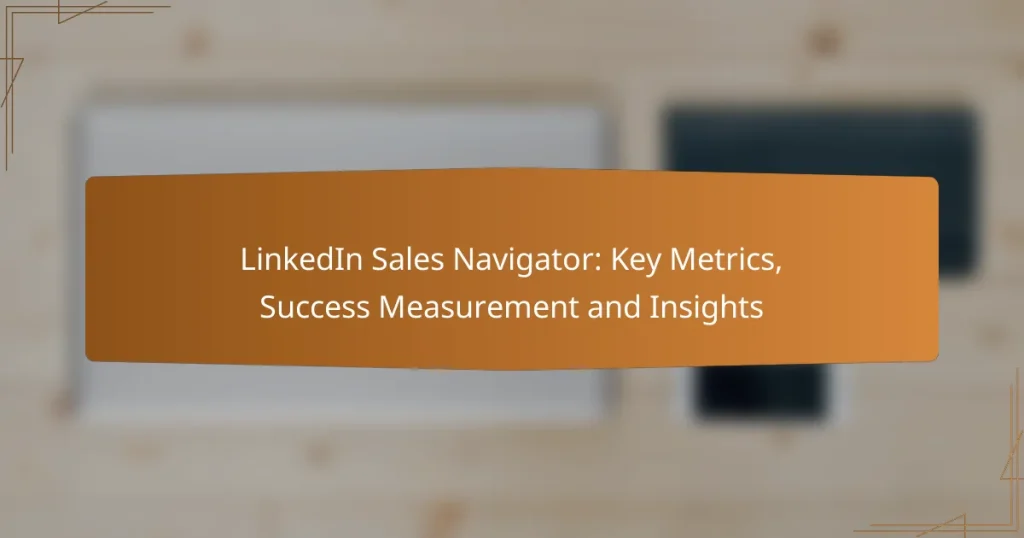LinkedIn Sales Navigator is a powerful tool for sales professionals, enabling them to track key metrics that measure success and optimize their outreach strategies. By analyzing performance indicators such as InMail response rates and lead recommendations, users can refine their approach to lead generation and enhance their overall sales effectiveness. Understanding these metrics allows for informed adjustments that can significantly impact sales outcomes.

How to measure success with LinkedIn Sales Navigator?
Measuring success with LinkedIn Sales Navigator involves tracking specific metrics that indicate how effectively the tool is being utilized to achieve sales goals. By focusing on key performance indicators, conversion rates, and engagement metrics, users can gain insights into their sales strategies and make informed adjustments.
Key performance indicators (KPIs)
Key performance indicators (KPIs) for LinkedIn Sales Navigator include metrics such as the number of leads generated, connection requests sent, and accounts saved. These indicators help assess the effectiveness of your outreach efforts and overall engagement with potential clients.
To effectively track KPIs, set specific targets based on your sales goals. For instance, aim to connect with a certain number of prospects weekly or monthly. Regularly review these metrics to identify trends and areas for improvement.
Conversion rates
Conversion rates reflect the percentage of leads that turn into actual sales or meaningful engagements. In the context of LinkedIn Sales Navigator, this can include metrics like the number of conversations initiated that lead to meetings or deals closed.
To improve conversion rates, focus on personalizing your outreach messages and following up consistently. A good benchmark is to aim for a conversion rate in the range of 10-20%, depending on your industry and target audience.
Engagement metrics
Engagement metrics measure how prospects interact with your content and outreach efforts. This includes metrics such as the number of profile views, InMail responses, and content shares. High engagement levels often indicate that your messaging resonates with your audience.
To enhance engagement, regularly analyze which types of content or messages yield the best responses. Experiment with different formats, such as videos or articles, and adjust your strategy based on what generates the most interest from your target market.

What are the key metrics in LinkedIn Sales Navigator?
The key metrics in LinkedIn Sales Navigator include InMail response rates, lead recommendations, and account insights. These metrics help sales professionals evaluate their outreach effectiveness, identify potential customers, and gain valuable information about target accounts.
InMail response rates
InMail response rates measure how often recipients reply to messages sent through LinkedIn Sales Navigator. A higher response rate indicates effective messaging and targeting, while lower rates may suggest the need for adjustments in approach. Aim for response rates in the low to mid double digits for optimal engagement.
To improve InMail response rates, personalize your messages based on the recipient’s profile and interests. Avoid generic templates and focus on creating a compelling subject line that captures attention. Tracking your response rates over time can help identify trends and refine your strategy.
Lead recommendations
Lead recommendations in LinkedIn Sales Navigator provide users with a curated list of potential prospects based on their preferences and past interactions. This feature uses algorithms to suggest leads that are most likely to convert, saving time and increasing efficiency in the sales process.
To maximize the effectiveness of lead recommendations, regularly update your preferences and criteria within the platform. Engage with suggested leads promptly to increase the chances of conversion. Monitoring the success of these recommendations can help you adjust your targeting criteria for better results.
Account insights
Account insights offer valuable information about companies, including updates on employee changes, recent activities, and industry trends. This data helps sales professionals tailor their outreach and understand the context of their target accounts.
Utilize account insights to identify key decision-makers and understand their challenges. Regularly reviewing these insights can inform your sales strategy and enhance your conversations with prospects. Consider setting alerts for significant changes within target accounts to stay informed and proactive.
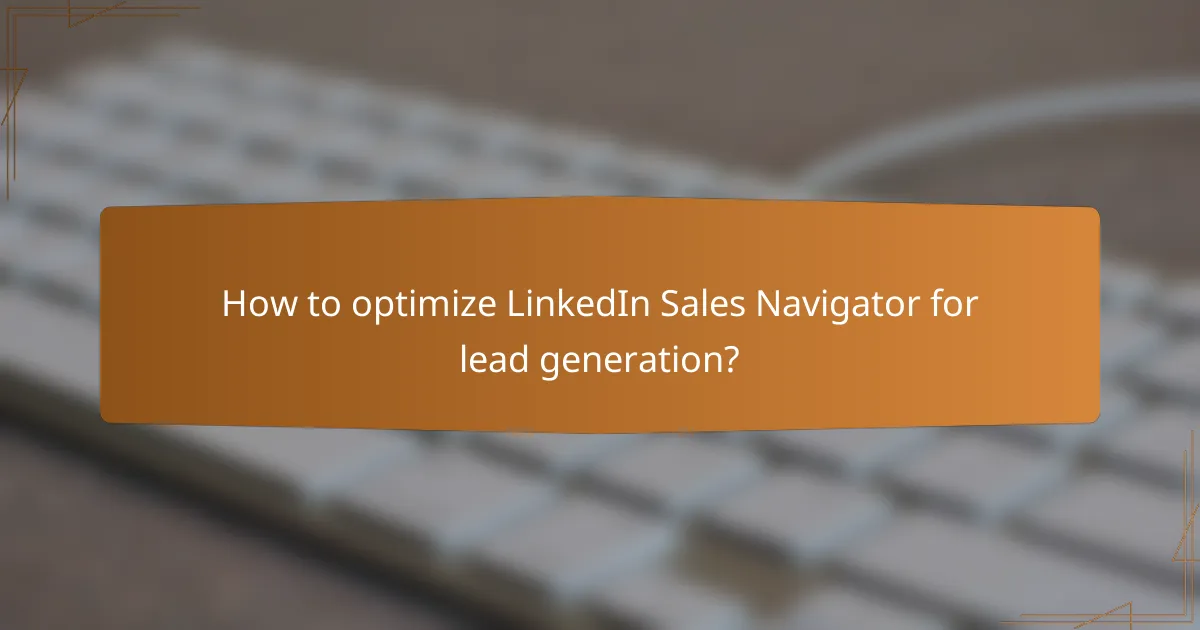
How to optimize LinkedIn Sales Navigator for lead generation?
To optimize LinkedIn Sales Navigator for lead generation, focus on refining your search criteria, personalizing your outreach, and effectively managing your saved leads. These strategies enhance your ability to connect with potential clients and improve your overall sales performance.
Targeted search strategies
Utilizing targeted search strategies involves using advanced filters to narrow down your leads based on specific criteria such as industry, company size, and location. This allows you to focus on prospects that are most likely to convert into clients.
Consider creating a list of ideal customer profiles to guide your searches. For example, if you are targeting tech startups, set filters for companies with fewer than 50 employees in the technology sector. This precision helps in maximizing your outreach efforts.
Personalized outreach techniques
Personalized outreach techniques are crucial for engaging potential leads. Start your messages with a personalized greeting and mention a common connection or interest to establish rapport. Tailor your message to address the specific needs or challenges of the prospect.
For instance, if you notice a lead recently shared an article about digital marketing, reference it in your message and suggest how your services can help them implement those strategies. This approach shows that you have done your homework and are genuinely interested in their success.
Utilizing saved leads and accounts
Utilizing saved leads and accounts effectively can streamline your follow-up process. Regularly review your saved leads to track their activity and engagement on LinkedIn, which can inform your outreach timing and messaging.
Set reminders for follow-ups based on their activity, such as if they post an update or change jobs. This proactive approach keeps you top-of-mind and can lead to more meaningful conversations. Consider categorizing your saved leads by priority to ensure you focus on the most promising prospects first.
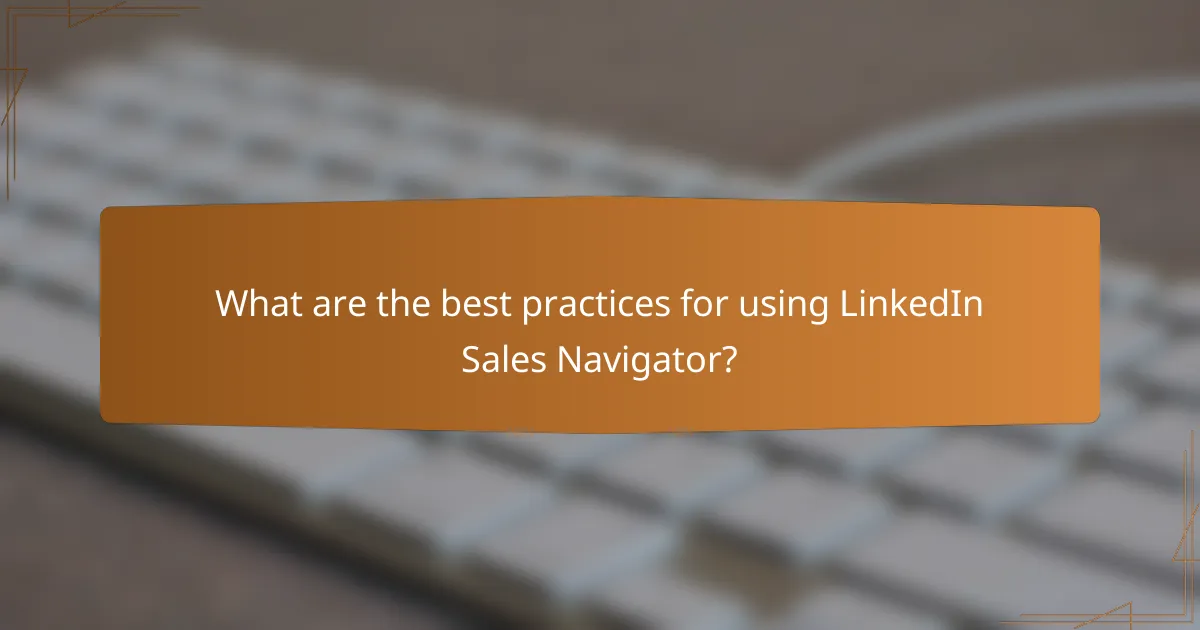
What are the best practices for using LinkedIn Sales Navigator?
To maximize the effectiveness of LinkedIn Sales Navigator, focus on maintaining updated lead lists, actively engaging with shared content, and monitoring competitor activity. These practices enhance your outreach and provide valuable insights into your market landscape.
Regularly updating lead lists
Keeping your lead lists current is crucial for effective sales outreach. Regularly review and refresh your lists to ensure you are targeting the right prospects. This can involve adding new leads, removing those who are no longer relevant, and adjusting your criteria based on changing market conditions.
Consider setting a schedule for updates, such as weekly or bi-weekly, to maintain consistency. Utilize filters to segment leads by industry, company size, or location, which can help tailor your approach and improve engagement rates.
Engaging with shared content
Engaging with content shared by your leads and connections can significantly enhance your visibility and rapport. Like, comment, and share relevant posts to demonstrate your interest and expertise in your industry. This interaction can lead to meaningful conversations and strengthen relationships.
Focus on providing thoughtful comments that add value to the discussion. Aim to engage with content regularly, as this can keep you top-of-mind for your connections and help you stay informed about industry trends and insights.
Tracking competitor activity
Monitoring competitor activity on LinkedIn is essential for staying competitive. Use Sales Navigator to follow competitors and observe their engagement strategies, content, and new hires. This information can inform your own tactics and help identify gaps in the market.
Set up alerts for key competitors to receive updates on their activities. Analyzing their successes and challenges can provide insights into potential opportunities for your business. Regularly review this information to adapt your strategies accordingly and maintain a competitive edge.
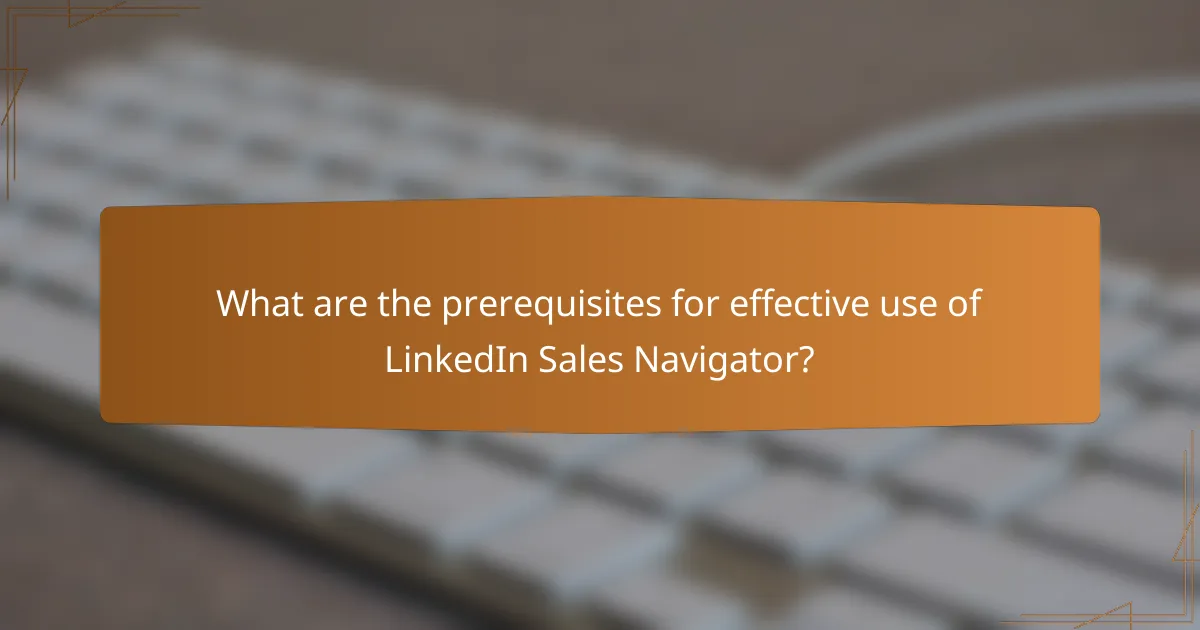
What are the prerequisites for effective use of LinkedIn Sales Navigator?
To effectively use LinkedIn Sales Navigator, you need a clear understanding of your target audience, well-defined sales goals, and a seamless integration with your CRM system. These prerequisites help maximize the platform’s potential for lead generation and relationship building.
Understanding your target audience
Identifying your target audience is crucial for leveraging LinkedIn Sales Navigator effectively. Focus on specific demographics such as industry, company size, and job titles that align with your ideal customer profile. This targeted approach ensures that your outreach efforts are relevant and impactful.
Utilize LinkedIn’s advanced search filters to refine your audience. You can segment potential leads based on various criteria, allowing you to tailor your messaging and increase engagement rates. Regularly updating your audience parameters based on market trends can enhance your targeting strategy.
Setting clear sales goals
Establishing clear sales goals is essential for measuring success with LinkedIn Sales Navigator. Define what you want to achieve, whether it’s increasing lead generation, improving conversion rates, or expanding your network. Specific, measurable goals will guide your activities and help assess your progress.
Consider using the SMART criteria—Specific, Measurable, Achievable, Relevant, and Time-bound—to set your sales objectives. For example, aim to connect with a certain number of decision-makers within a specified timeframe. Regularly review and adjust these goals based on performance metrics.
Integrating with CRM systems
Integrating LinkedIn Sales Navigator with your CRM system is vital for streamlining your sales processes. This integration allows for seamless data transfer, ensuring that lead information is consistently updated across platforms. It enhances your ability to track interactions and manage relationships effectively.
Choose a CRM that supports LinkedIn integration, such as Salesforce or HubSpot, to maximize efficiency. This connection enables you to view LinkedIn profiles directly within your CRM, making it easier to personalize outreach and follow up on leads. Regularly assess the integration to ensure it meets your evolving sales needs.
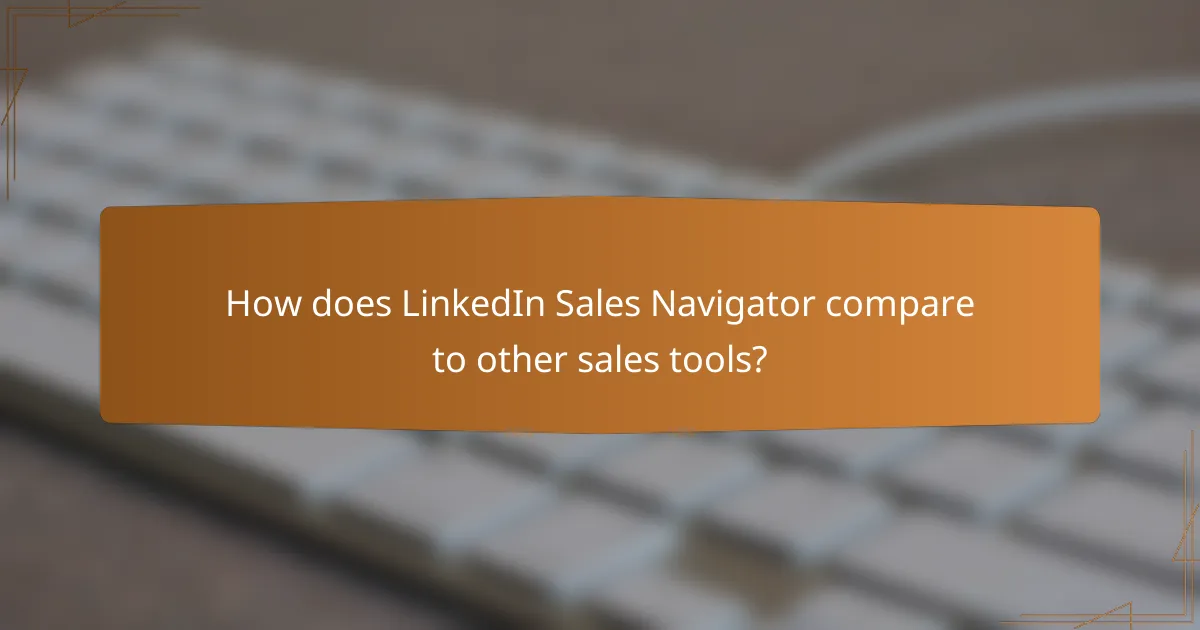
How does LinkedIn Sales Navigator compare to other sales tools?
LinkedIn Sales Navigator stands out among sales tools due to its extensive network and advanced search capabilities. It offers unique features that facilitate lead generation and relationship building, making it a preferred choice for many sales professionals.
Salesforce integration
LinkedIn Sales Navigator integrates seamlessly with Salesforce, allowing users to sync leads and accounts directly. This integration enhances productivity by enabling sales teams to access LinkedIn insights within their Salesforce environment, streamlining the sales process.
Users can leverage LinkedIn data to enrich Salesforce records, ensuring that sales representatives have the most relevant information at their fingertips. This connection can significantly improve lead conversion rates by providing context and background on potential clients.
HubSpot compatibility
Sales Navigator also offers compatibility with HubSpot, which allows for easy tracking of leads and interactions. This integration helps users manage their sales pipelines more effectively by combining LinkedIn’s networking capabilities with HubSpot’s marketing tools.
Sales teams can benefit from automated updates and insights from LinkedIn, which can be directly reflected in their HubSpot dashboards. This synergy supports better decision-making and targeted outreach efforts.
Comparative pricing analysis
When comparing pricing, LinkedIn Sales Navigator typically operates on a subscription model, with costs ranging from approximately $80 to $150 per month, depending on the plan. This pricing is competitive when considering the specialized features it offers for lead generation.
In contrast, Salesforce and HubSpot also have subscription fees that can vary widely based on the level of service and features included. While LinkedIn Sales Navigator may seem pricier at first glance, its unique capabilities can justify the investment for businesses focused on B2B sales.
